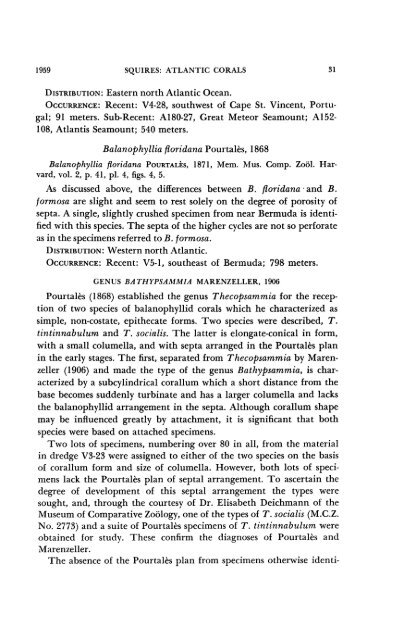MXieuicanJAuscum - American Museum of Natural History
MXieuicanJAuscum - American Museum of Natural History
MXieuicanJAuscum - American Museum of Natural History
You also want an ePaper? Increase the reach of your titles
YUMPU automatically turns print PDFs into web optimized ePapers that Google loves.
1959<br />
SQUIRES: ATLANTIC CORALS<br />
DISTRIBUTION: Eastern north Atlantic Ocean.<br />
OCCURRENCE: Recent: V4-28, southwest <strong>of</strong> Cape St. Vincent, Portugal;<br />
91 meters. Sub-Recent: A180-27, Great Meteor Seamount; A152-<br />
108, Atlantis Seamount; 540 meters.<br />
Balanophyllia floridana Pourtales, 1868<br />
Balanophyllia floridana POURTALES, 1871, Mem. Mus. Comp. Zool. Harvard,<br />
vol. 2, p. 41, pl. 4, figs. 4, 5.<br />
As discussed above, the differences between B. floridana and B.<br />
formosa are slight and seem to rest solely on the degree <strong>of</strong> porosity <strong>of</strong><br />
septa. A single, slightly crushed specimen from near Bermuda is identified<br />
with this species. The septa <strong>of</strong> the higher cycles are not so perforate<br />
as in the specimens referred to B. formosa.<br />
DISTRIBUTION: Western north Atlantic.<br />
OCCURRENCE: Recent: V5-1, southeast <strong>of</strong> Bermuda; 798 meters.<br />
GENUS BA THYPSAMMIA MARENZELLER, 1906<br />
Pourtal'es (1868) established the genus Thecopsammia for the reception<br />
<strong>of</strong> two species <strong>of</strong> balanophyllid corals which he characterized as<br />
simple, non-costate, epithecate forms. Two species were described, T.<br />
tintinnabulum and T. socialis. The latter is elongate-conical in form,<br />
with a small columella, and with septa arranged in the Pourtales plan<br />
in the early stages. The first, separated from Thecopsammia by Marenzeller<br />
(1906) and made the type <strong>of</strong> the genus Bathypsammia, is characterized<br />
by a subcylindrical corallum which a short distance from the<br />
base becomes suddenly turbinate and has a larger columella and lacks<br />
the balanophyllid arrangement in the septa. Although corallum shape<br />
may be influenced greatly by attachment, it is significant that both<br />
species were based on attached specimens.<br />
Two lots <strong>of</strong> specimens, numbering over 80 in all, from the material<br />
in dredge V3-23 were assigned to either <strong>of</strong> the two species on the basis<br />
<strong>of</strong> corallum form and size <strong>of</strong> columella. However, both lots <strong>of</strong> specimens<br />
lack the Pourtales plan <strong>of</strong> septal arrangement. To ascertain the<br />
degree <strong>of</strong> development <strong>of</strong> this septal arrangement the types were<br />
sought, and, through the courtesy <strong>of</strong> Dr. Elisabeth Deichmann <strong>of</strong> the<br />
<strong>Museum</strong> <strong>of</strong> Comparative Zoology, one <strong>of</strong> the types <strong>of</strong> T. socialis (M.C.Z.<br />
No. 2773) and a suite <strong>of</strong> Pourtales specimens <strong>of</strong> T. tintinnabulum were<br />
obtained for study. These confirm the diagnoses <strong>of</strong> Pourtales and<br />
Marenzeller.<br />
The absence <strong>of</strong> the Pourtales plan from specimens otherwise identi-<br />
31
















